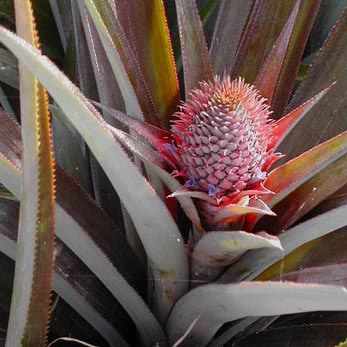PLANT KINGDOM
Pineapple and the Plant Kingdom
Pineapple is included in the family of Bromeliads (so-called ‘air’ plants) which contains 50 genus and over 2,000 species. Along Fig Tree Drive you will see tall Kapok trees (Silk Cotton) with pineapple-like plants perched on their limbs. These are also Bromeliads.
The species Comosus is the only one producing commercially grown fruit crops. The Comosus species comprises 5 groups shown below, including the largest group called Cayenne, which James Dole made famous in Hawaii. Our Antigua Black pineapple is of the Queen group. Other varieties in the Queen group are listed with their major area of cultivation noted.
Family: Bromeliad
Genus: Ananas
Species: Comosus
Groups:Queen, Maipure, Pernambuca, Spanish, Cayenne (“Dole”)
Cultivars of the Queen group: Antigua Black (Antigua, W, Indies), Natal Queen (S. Africa), MacGregor (Australia), Mauritius (Malaysia)
The Pineapple Crop Cycle
If you want to grow pineapple, you’d better have a lot of patience. Antigua Black pineapples require at least 18 months to produce their first crop. After fruit harvest, suckers grow out from the base of the mother plant. When left on the plant these suckers will grow and produce a second (ratoon) crop of fruit a year later.
Under ideal conditions, newly planted suckers begin to root within 2 to 3 weeks. With adequate fertility and water, Antigua Black pineapple plants will double in mass every 4 months. By the time the pineapple plant is about 12 to 14 months old, it should be of sufficient mass to produce a good sized fruit.
At this point, the plant is ‘induced’ to flower (see ‘Flowering‘). Six weeks after induction, a flower bud arises out of the central ring of young leaves. Over the following two weeks, 200 to 300 flower buds will open up on each fruit, one after the other, starting at the base of the fruit and ending at the top. Each fruitlet becomes an ‘eye’, and all these fruitlets fuse together to form one pineapple.
It then takes another 3 months to complete the filling, maturation, and ripening of the fruit. At Claremont Farms we do not ripen the fruit artificially. Instead, each plot is harvested over a three week period as the fruits ripen naturally.
Flowering
Pineapple flowers naturally only once a year. The plants can sense the increasing day length by late January or early February (northern hemisphere). Plants that are mature enough will initiate flower buds that cannot be seen until the small, red bud arises out of the central ring of leaves 6 weeks later. It requires another 3 1/2 months to complete the filling, maturation, and ripening of the fruit. Therefore, in all it takes 5 months (February to July) for a mature plant to finally produce a fruit.
Artificial Induction
For the past 60 years, growers have been able to ‘induce’ pineapple plants to flower at any time of year. Anything that produces ethylene gas will cause a mature pineapple plant to ‘differentiate’, changing from the vegetative stage to reproductive stage of growth.
Mature fields are induced in succession to suit the projected demand. In this way, a constant supply of fresh fruit can be marketed year-round.
Quality vs. Quantity
Efforts to improve crops of all kinds require compromise between quality and quantity. When a fruit crop is selected for higher yield (quantity), one must ultimately sacrifice characteristics of quality (high sugar, high nutrient content, low fibre content, low acid content, reduced water content, higher disease resistance).
Our Antigua Black pineapple has never undergone such a selection process and as a result, it still possesses those qualities bred out of the modern, higher yielding commercial Hawaiian varieties.
Claremont Farms has made a commitment to promote and improve our pineapple without compromising these desirable characteristics. Though we do have to concede that the Hawaiian varieties can out yield our Antigua Black by 6 to 1, improvements in cultivation, irrigation and nutrition should narrow the gap in future generations.
Drought Resistance
Pineapple has defenses against excessive water loss.
1. To begin with, the plant does not “breathe” during the heat of the day. Unlike most plants, the pineapple opens its pores (stomata) during the night rather than the daytime. Most species open their stomata during the day to avoid overheating.
2. Pineapple also has a special layer of water storage cells on the underside of the leaf that act as a reserve in times of water stress.
3. The epidermis of the leaf is especially thick and tough to resist damage and desiccation.
4. The roots are able to resist wilting, prepared for the moment soil moisture becomes available.
Photo Credit – Greg Reedman

